
Tablet Weaving and Ply-Splitting Books, Tools & Kits
A brocaded tablet-woven dagger belt from Yemen
and the continuation of the Yemeni tradition of tablet-woven brocade
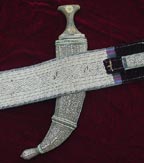 Click on any photo for a larger view.
Click on any photo for a larger view.
Marta Colburn is a consultant and textile collector whose work frequently takes her to Yemen. Here is her story of discovering tablet weaving in San'a'.
In July 2002 I visited the Women's Handicraft Center in San'a', the capital of Yemen. This charitable society provides a fair trade opportunity for low-income women. It teaches them crafts, provides materials, quality control and sales, and works to preserve Yemen's cultural heritage. I frequently visit this center to purchase embroidered items. On my last visit, as I was leaving, the director, Amal al-Razak Jahaf, called me aside and said she wanted to show me a new project. As I was rushed for time, I almost did not take the opportunity. She described to me how she had researched this tradition, which she called Tazja'h. She said she had been searching for someone to teach the craft to the women and had finally located an artisan that she beleives is one of the only Yemenis that still knows the craft. Then we entered the room.
Inside was an old man sitting on the floor teaching a young woman how to weave. As I gazed at the scene I suddenly realized they were tablet weaving. I got very animated, asking many questions and requested to take a picture, which unfortunately, the craftsman refused. As I was leaving, I had the foresight to ask if they had anything tablet-woven that I could purchase. They said "no" and then added ""except for the first sample they had woven." They showed me the band seen here, and I asked to purchase it. They had no idea how much to charge so I just gave them $50 (an enormous sum in local terms) and asked them to consider it as a donation to the charitable society.
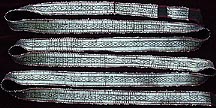
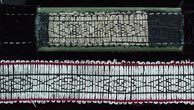 When I returned to Portland, I showed the band to Linda, along with a dagger (jambia) and dagger belt that I purchased in San'a' in 1989. I had not realized that my dagger belt was also tablet woven, but they are both clearly the same technique. The band woven by the master craftsman and his apprentice in 2002 is 1-1/8" wide, about the same width as the buckle cover on the belt, and is 116" long. The craftsman, Mohammed Ali Radami, is from Bani Matar, an area west of San'a' (the capital city).
When I returned to Portland, I showed the band to Linda, along with a dagger (jambia) and dagger belt that I purchased in San'a' in 1989. I had not realized that my dagger belt was also tablet woven, but they are both clearly the same technique. The band woven by the master craftsman and his apprentice in 2002 is 1-1/8" wide, about the same width as the buckle cover on the belt, and is 116" long. The craftsman, Mohammed Ali Radami, is from Bani Matar, an area west of San'a' (the capital city).
The jambia and the tablet-woven belt
Men in Yemen do not commonly wear jewelry, except for silver rings. The one exception is the decorative dagger called a jambia, which is a common item of dress for most highland Yemeni men. The jambia has great symbolic value establishing one's place in social hierarchies and tribal membership, though it is rarely used as a weapon. The j-shaped version of this dagger, asib, is worn by tribesmen, while judges, legal scholars and religious elites wear a more gently-curved version called a thuma or tuza (similar to the one in this picture). This version worn by elites often displays very intricate and exquisite silver craftsmanship on the sheath.
The belt is an important decorative and functional element of the jambia. Leather is covered with velvet and other fabric embellished with geometric or religious designs in metallic gold or silver thread. The designs may be embroidered or, as in the case of my belt, tablet-woven brocade. Traditionally various silver crafted items would be sewn to the belt for decorative and functional purposes (powder horn, money pouch and amulets).
-- Marta Colburn
August 2002
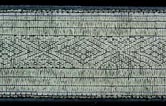
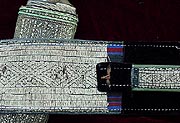 Details of Marta's dagger belt
Details of Marta's dagger belt
The dagger belt in Marta's collection is 40" long, and the ends are leather covered with black velvet. The decorative area consists of warp-twined cotton as the ground cloth, with supplementary weft brocade of silver threads. The main brocaded section of the belt is 2-7/8" wide and 36-1/4" long. The brocade on the small strap (buckle cover) is 7/8" wide and 2-7/8" long.
Tablet-woven brocade in Yemen using a draw apparatus
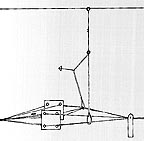 In The Techniques of Tablet Weaving by Peter Collingwood, Plate 195 shows a strap from a dagger belt which is very similar to the band which Marta purchased in July 2002. The accompanying text, based on an article* by Aviva Klein in 1974, describes the use of a draw apparatus to create these belts. Peter's drawing of this device, Fig. 198, is shown here. Marta says this seems to be the method she observed at the Women's Handicraft Center. Thanks to Peter for permission to use his description and illustration here:
In The Techniques of Tablet Weaving by Peter Collingwood, Plate 195 shows a strap from a dagger belt which is very similar to the band which Marta purchased in July 2002. The accompanying text, based on an article* by Aviva Klein in 1974, describes the use of a draw apparatus to create these belts. Peter's drawing of this device, Fig. 198, is shown here. Marta says this seems to be the method she observed at the Women's Handicraft Center. Thanks to Peter for permission to use his description and illustration here:
"On a cord stretched from wall to wall above the warp, there was a ring from which hung the draw mechanism. This consisted of a rod to which as many strings were attached as there were cords in the pattern area of the band. Each string ended in a loop which encircled the four threads from a tablet, between the latter and the comb. Pulling on one of the strings raised these threads plus their tablet. The two upper threads from this tablet were lifted above the level of the adjacent threads and provided a shed for the brocading weft.
So that strings did not have to be selected individually for each passage of the weft, a loop was put round all strings required for the first brocading pick, another loop around all strings required for the second pick and so on. So there were as many such loops as there were different brocading sheds needed for the design. Then by pulling these loops in succession, exactly as on a drawloom, the strings required for each brocading pick were automatically selected.
The shed made by pulling the strings with one hand was very small and had to be enlarged by slipping the other hand or a sword under the raised pairs of threads before the brocading weft could be passed. A comb was essential to keep the warp threads well separated so that groups of four could be freely selected.
As the work proceeded, the apparatus could be slid on its ring along the suspending cord and so always hung in the correct position.
With this apparatus, bands brocaded with hammered silver strip or metal-wrapped yarns were woven on a black, green, or red cotton warp. They were sewn onto a leather backing and used as belts, or sewn together into caps, or used as borders for garments. Presumably once such a device has been made, it would also make easier the weaving of non-repeating patterns."
* Klein, Aviva, 1974. Tesig-Bandweberei mit Gold- und Silberfaden in San'a' in Baessler Archives, Neue Folge, Vol. XXII, Part 2 Berlin. This article was also published in English in The Fabrics of Culture: Anthropology of Clothing and Adornment. The Hague, Paris, New York, 1979. Tabletweaving by the Jews of San’a (Yemen) p. 429-445.
Tablet Weaving Gallery
Home
This page updated on June 20, 2013.
![]()
 Click on any photo for a larger view.
Click on any photo for a larger view.
 When I returned to Portland, I showed the band to Linda, along with a dagger (jambia) and dagger belt that I purchased in San'a' in 1989. I had not realized that my dagger belt was also tablet woven, but they are both clearly the same technique. The band woven by the master craftsman and his apprentice in 2002 is 1-1/8" wide, about the same width as the buckle cover on the belt, and is 116" long. The craftsman, Mohammed Ali Radami, is from Bani Matar, an area west of San'a' (the capital city).
When I returned to Portland, I showed the band to Linda, along with a dagger (jambia) and dagger belt that I purchased in San'a' in 1989. I had not realized that my dagger belt was also tablet woven, but they are both clearly the same technique. The band woven by the master craftsman and his apprentice in 2002 is 1-1/8" wide, about the same width as the buckle cover on the belt, and is 116" long. The craftsman, Mohammed Ali Radami, is from Bani Matar, an area west of San'a' (the capital city). 
 Details of Marta's dagger belt
Details of Marta's dagger belt  In The Techniques of Tablet Weaving by Peter Collingwood, Plate 195 shows a strap from a dagger belt which is very similar to the band which Marta purchased in July 2002. The accompanying text, based on an article* by Aviva Klein in 1974, describes the use of a draw apparatus to create these belts. Peter's drawing of this device, Fig. 198, is shown here. Marta says this seems to be the method she observed at the Women's Handicraft Center. Thanks to Peter for permission to use his description and illustration here:
In The Techniques of Tablet Weaving by Peter Collingwood, Plate 195 shows a strap from a dagger belt which is very similar to the band which Marta purchased in July 2002. The accompanying text, based on an article* by Aviva Klein in 1974, describes the use of a draw apparatus to create these belts. Peter's drawing of this device, Fig. 198, is shown here. Marta says this seems to be the method she observed at the Women's Handicraft Center. Thanks to Peter for permission to use his description and illustration here: